Help students find the strength and confidence to overcome obstacles in their own lives.

In middle school, students begin their exploration of identity in earnest, and they often feel the pressures of increased expectations. They're also in the intense, early stages of transition between child and young adult -- as middle school teachers know first hand! While the movie Whale Rider is set in New Zealand and reflects Māori traditions and culture, it's relatable to kids everywhere. The film connects with universal themes of adolescence, and tackles topics like loss, courage, self-worth, and community.
The story follows Paikea (Pai), who has disappointed her community by being born a girl. Despite experiencing loss and the narrow expectations set for her, Pai listens to her instincts, pursues learning, and brings her community together with courage. Though, at times, the movie dips into the misleading cliche that "If you only try hard enough you can overcome anything," Pai's story is ultimately much more complex. In this way, Whale Rider shows students that the world doesn’t always bend to effort and willpower, but even so, standing firm in one’s principles and having self worth is very powerful.
Things to Know Before You Show Whale Rider to Your Students
This guide offers two different approaches to teaching Whale Rider:
- Show a few specific clips along with discussion questions.
- Show the entire film with a more in-depth lesson plan and handout.
Feel free to use either approach, or even combine the two into one lesson (or an entire unit) based around the movie. If you only have a single class period, showing just a few key clips below might be perfect. If you decide to help students delve deeper into the topic, you might show the entire film and have more extensive discussions over multiple days. Of course, you could also use some combination of the two, adapting the lesson to best suit your class's needs.
Content warning: There are a few scenes to be aware of before showing the movie. You know your classroom and community norms best -- use your professional judgment to decide how you'll address these, if necessary.
- At the 38:00, Koro tells the boys that the consequence of not learning a chant is that their "dicks will fall off" so they should "hold onto their dicks."
- At 56:27, Uncle Rawiri is napping with a bag of cannabis and a pipe on his chest.
- Scattered throughout the film, there are scenes of adults drinking beer and smoking. At 32:50, there's a scene in which a boy is smoking.
Lesson Objectives
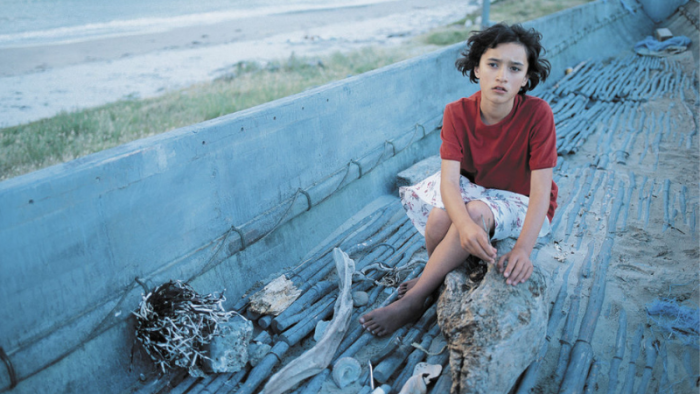
This lesson is designed to align with the CASEL 5 competencies for social and emotional learning as well as various thinking routines from the Harvard Graduate School of Education's Project Zero.
Use this lesson to help students consider how they can:
- Exhibit self-discipline and self-motivation.
- Show the courage to take initiative and experience self-efficacy.
- Demonstrate personal and collective agency.
- Integrate their personal and social identities.
- Identify their personal, cultural, and linguistic assets.
- Examine their own prejudices and biases.
- Identify diverse social norms, including unjust ones.
- Understand the influences of organizations and systems of behavior.
- Anticipate and evaluate the consequences of their actions.
- Reflect on their role in promoting personal, family, and community well-being.
Whale Rider Clips and SEL Discussion Questions for Students
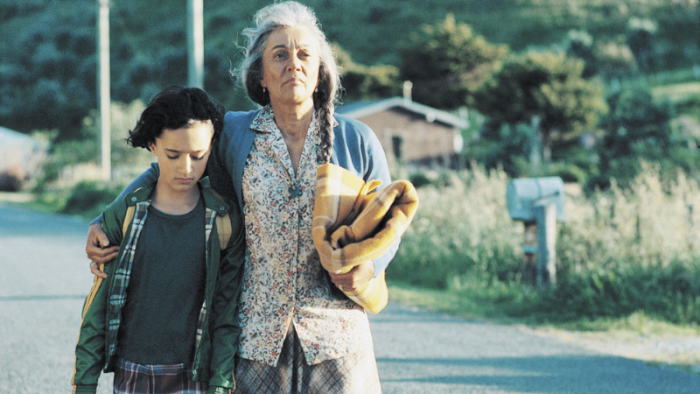
If you only want to show brief parts of the film and discuss them with students, use these helpful clips to get you started. You can also use these in conjunction with the longer lesson plan below.
The time stamps can help you pick and choose your areas of focus. Use as few or as many clips as you see fit, but keep in mind that you may need to introduce the movie's overall plot and talk through some of what happens before or after each clip.
Clip #1: Porouragi is angry that Koro, his father, seems to care only about having a grandson instead of acknowledging his loss. Koro is also upset about his granddaughter’s name -- Pai. (4:23-5:52)
- Discuss: Both men are experiencing intense feelings. What is Porouragi feeling? What about Koro? Why does Porouragi finally leave the conversation?
Clip #2: Nanny’s son (and Pai’s uncle) asks Nanny if Koro's disappointment in him started right at birth. Nanny says, "You're a man. You can handle it." (7:23-7:34)
- Discuss: What does it mean when Nanny says, "You're a man. You can handle it?" What expectations does it imply?
Clip #3: Pai explains that her father stopped carving his boat after she was born, and says, "He went away. Everybody did." (15:04-15:25)
- Pai's dad travels around the world as an artist while she stays with his parents in New Zealand. Then she mentions the unfinished boat and says everyone went away. What do you think she means? How are the two ideas -- the unfinished boat and people leaving -- related to each other?
Clip #4: Koro tells Pai about the origin of their ancestors using a rope. When it breaks, Pai fixes it but it makes Koro mad. (17:00-19:28)
- Pai wants to know about the history of her people. Why do you think this is important to her? What do you know about your family's or culture's history that adds to your sense of self?
- Why is Koro angry when Pai fixes the problem? Is it really because he's worried for her safety?
- Koro uses the rope as a metaphor to explain how community makes people stronger. What's another comparison that conveys the same idea?
Clip #5: Koro wants Porouragi to stay and be a mentor to the boys in the village, but Porouragi doesn't feel seen or understood. Koro says to Porouragi: "I know who you're meant to be, who you were born to be." (22:10-24:06)
- When Koro says, "I know who you're meant to be, who you're born to be," he clearly has expectations for Porouragi. How does Porouragi feel about those expectations? Is having expectations for someone a good thing, a bad thing, or does it depend?
Clip #6: Porouragi and Pai talk about how Koro wants a prophet, and that neither of them can be what he wants. (24:38-27:47)
- Both Porouragi and Pai know they disappoint Koro, and it makes them sad and angry. How can caring about someone else's expectations for you be positive, negative, or somewhere in between?
Clip #7: Pai is leaving with her father, but she tells him to stop and take her back. At the same time, we see a whale surfacing. (30:37-32:13)
- Why do you think the moviemakers show the whale around the same time Pai decides she wants to go back?
Clip #8: Pai shows up at the school gathering of boys Koro arranged. Because she’s a girl, Koro wants Pai to sit in the back but she doesn’t. (34:10-37:19)
- Even though Pai loves and respects her grandfather, she chooses to disobey him. Why?
Clip #9: Pai gets secret lessons from Hemi about the Taiaha, a weapon. Koro finds them and tells Pai, "I'll deal with you later." (38:39-41:02)
- Pai chooses to disobey Koro's rules so she can learn what the boys are learning. Can you think of other examples -- from the present or the past -- when learning and knowledge was only allowed for certain people?
- Despite Koro's rejection, Pai stands firm. How do you think she's able to do that?
Clip #10: Nanny says, "He's got a lot of rules he's got to live by." Nanny hints to Pai that Uncle Rawiri can teach her the Taiaha. (43:02-44:32)
- Nanny says Koro has lots of rules to live by. Since no one is telling him what to do, and he makes the rules for everyone else, we know those rules he's living by come from inside him. What expectations or rules do you have for yourself?
- Just because we have expectations for other people doesn't mean they'll live up to them. So what can we control?
Clip #11: Koro discovers Hemi and Pai fighting with Taiaha. Koro asks Pai: "What have you done?" Hemi defends Pai, but Koro tells her she's ruined the school. (49:33-54:15)
- Why is Hemi sad? What does he want? Why does he start using his Taiaha when Pai finds him?
- Traditions and beliefs are often sacred to people, so to have them disrupted can make things feel broken or ruined. Is there a way to respect traditions and beliefs and still make room for people like Pai?
Clip #12: After Pai dives down to get Koro's necklace (rei puta) she says it's quiet down deep and that Nanny says Koro needs quiet and isn’t ready to know she found the necklace. (1:03:48-1:06:37)
- It is literally quiet down deep in the ocean, but what else does Pai mean? Are there ways that you sometimes go down deep, into the quiet?
- Why doesn't Nanny think Koro is ready to know Pai is the one who found the rei puta?
Clip #13: Pai gives her award-winning speech and starts to cry because Koro isn't there. Meanwhile, Koro was headed to the concert but goes to the beach instead and sees a pod of beached whales. (1:11:14-1:15:34)
- What parts of Pai's speech caught your attention? Why?
- Throughout history, leaders have been born, chosen, and made in all kinds of ways. What do you think it means to be a leader?
Clip #14: The villagers go down to the whales, and Koro asks, "Who is to blame?" The villagers fail to move the whale. Later, Pai climbs onto the whale, who begins to move. Nanny gives Koro his necklace. (1:16:07-1:30:40)
- Koro asks, "Who is to blame?" Even though sometimes problems are complicated or just happen, why is it easier to have someone to blame?
- Though the whales beaching themselves is sad and upsetting, are there any positive things that happen for the humans in the story?
- How do you think Koro feels as Nanny hands him his rei puta?
Clip #15: Koro by Pai's bedside. The whole village launches dad's finished boat. (1:33:11-End)
- What are three specific details that make this a positive ending?
- Why do you think the filmmakers ended the movie this way?
Whale Rider Lesson Plan and Graphic Organizer
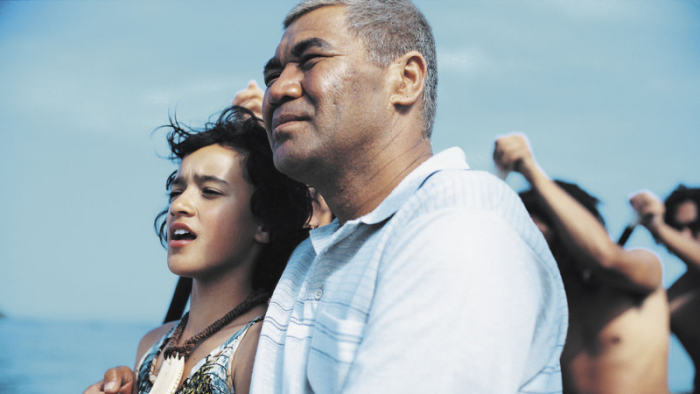
Begin by introducing the movie and give students some context about why it’s worth thinking about more deeply. Though it's no longer a hugely popular movie, it's possible that some kids will have already seen it, so it's helpful to make a strict "If you know it, don't blow it" rule to prevent spoilers. You might also want to discuss some of the learning objectives or the concept of active viewing.
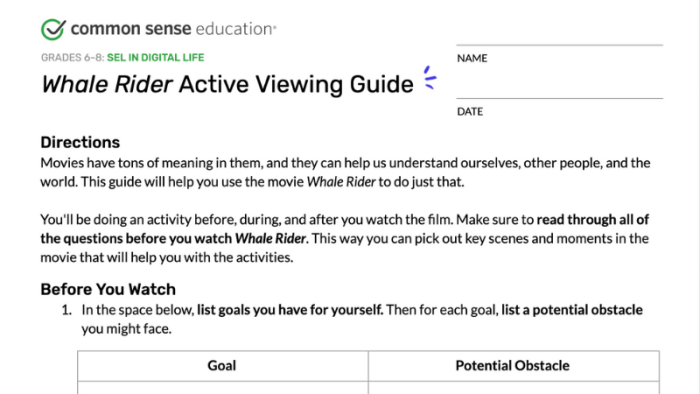
Before the Movie
Hand out copies of the Whale Rider Active Viewing Guide, and give students a few minutes to finish the Before You Watch question.
- Students will be listing some of their goals and potential obstacles in a table. Importantly, they’ll return to this after the movie and reflect on it.
- If students need an example, a goal might be "becoming a doctor" and the obstacle might be "not having money for college." Another could be "playing high school football" and "not being allowed because you're a girl."
Preview the activities students will be doing during the movie. Students will be writing down notes about four prompts: Examples of how Pai ...
- Trusts her instincts.
- Seeks knowledge.
- Challenges limits.
- Shows courage.
Once the movie is over, you can use all of the questions and activities or just pick and choose, depending on how much time you have. You might also choose to have students work in pairs, small groups, or together as a whole class.
During the Movie
Make sure to pause periodically (feel free to use the timestamps above) and give kids a chance to write or draw responses to the prompts on their handouts.
After the Movie
Have students complete the After You Watch activities.
- You can use all of the questions and activities or pick and choose, depending on how much time you have.
- Students can write down responses individually and then discuss in pairs, small groups, or as a whole class.
- As you see fit, use the selected scenes and discussion questions listed earlier in this article to guide a class discussion about the movie.
Writing Prompts
You can use these additional prompts (which don't appear on the student handout) to guide students in a writing project or a more comprehensive discussion about the movie's major themes.
- Much of the movie is about respecting where you come from while remaining open to change. How can a person -- or society -- decide what values, traditions, and expectations to keep the same, and what to rethink or revise?
- Niki Caro, the director of the movie said, "When I made Whale Rider -- of course, I'm not Māori and have no business, as a white girl, telling people how to be in this movie –- I started by learning the language as best I could. I spent lots of time in the community. I realized that by being on the ground, eating the food...I could experience the truth and beauty of a culture. It's not about me. I am absolutely in service of the truth of the story. I've made every movie since Whale Rider in that way." What are your feelings about someone outside of a community becoming a storyteller for that group?
- This story involves a lot of loss and grief, but also hope and courage. How it it possible for these emotions -- which seem like opposites -- to happen together?
- Pai deals with a lot of rejection from Koro just because she's a girl. How can someone accept themselves when they don't feel accepted by others?
Creative Extensions
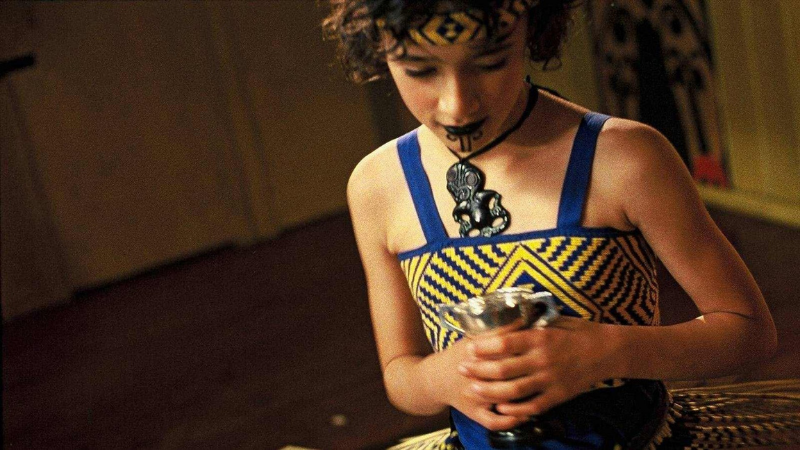
- Pai's story is based on a legend from the Māori tradition, but many of the challenges and messages are universal. Create a different story that conveys the same messages using whatever method you choose.
- Witi Ihimaera uses magical realism in Whale Rider. Magical realism is when a story is set in the real world, but there are some elements of fantasy. Create your own story using magical realism.
- Ask your family or do some research about your cultural traditions, beliefs, and legends, or customs. Pick one, learn about it, and prepare a visual or demonstration to share with the class.







